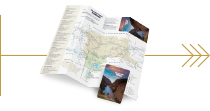Notes from the Road: Outdoor Sports You’ve Never Tried: Ice Climbing

This is the beginning of a new series that we’re calling, "The Best Sports You’ve Never Heard Of."
Living in Montana’s Yellowstone Country means having access to a whole host of athletic opportunities. But while mainstream sports abound, there’s somewhat of an alternative trending in this area of people who want to take already extreme sports to the next level. Today, we’re talking about ice climbing.
We’re starting off easy, as we’d guess that most of you may have heard of ice climbing, but we’re asking, "But how much do you really know?"
What it is? Ice climbing is exactly what it sounds like; strapping into a harness and rope system (similar to one used during rock climbing) and scrambling your way up ice using special tools to secure your grip.
There are two types of ice in the sport: alpine ice (usually presenting itself in a mountain environment, such as on a glacier) and water ice (climbing frozen waterfalls or otherwise frozen, flowing water). We’ll be discussing mostly water ice climbing, as Yellowstone Country has some of the best water ice climbing in the U.S.
How did it come about? Ice climbing is actually an old sport. Used practically (I say that lightly because climbing ice seems about as practical as hurling yourself off a cliff without a parachute … another sport we’ll get into eventually) by mountaineers aiming to summit the world’s highest peaks during the age of exploration at the turn of the twentieth century, it became popular as a means of recreation only recently.
What are the main tools needed? A climbing harness, rope, crampons (metal spikes that can be attached to climbing boots to dig your feet into the ice), ice tools (like ice picks that you hold in your hands to pull yourself up), ice screws for screwing protection into the ice, and climbing gear like quick draws and a belay device.
What makes this sport so popular with extreme adventurists?
"There’s an old ice climbing joke that goes like this: ‘the first rule is don’t fall, second rule is don’t look down, third rule is stop smiling, this isn’t fun,’" says Jonah Barta. Barta was an avid rock climber who took up ice climbing when he moved to Yellowstone Country a few years ago. He has hopes of being a ski mountaineer (climbing hard-to-reach peaks in an attempt to descend them on skis). Adding ice climbing skills into his repertoire was a necessity to reach that goal.
Barta also admits that falling while rock climbing can lead to some nasty injuries, but falling while ice climbing is even a bit more precarious. With razor-sharp crampons (think metal claws or talons) strapped to your feet, the slightest dig into the ice or catch on the clothing could be a disaster. Hence the "don’t fall" rule.
What makes Yellowstone Country a burgeoning community for this sport? Hyalite Canyon, located just south of Bozeman, is one of the best places in the nation to ice climb, due to its abundant flowing water ice and consistently cold conditions.
"There aren’t that many spots that consistently have solid ice flows in the U.S., which make Hyalite a mecca of sorts, with people traveling from all over the country to climb," Barta confirms.
Even if you’re not interested in climbing, Barta recommends checking out the G1 Wall of Hyalite Canyon. It has tons of climbing routes and, on a cold day, will have at least a few climbers out there that you can watch.
What’s the best way to get started in the sport?
Fortunately, this is a sport that’s within both athletic and financial reach for most people, even beginners. According to Barta, there’s a company called ProLite, in Bozeman, who will help you choose all the gear you’ll need. On Wednesday nights, they even take people ice climbing, teaching them how to climb by lamplight.
Ice climbing is extreme, yet not unreachable. Do you have any questions about the sport or how to get started? Leave them in the comments below.


